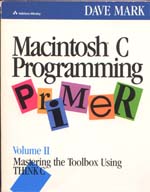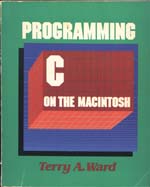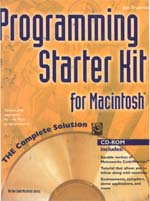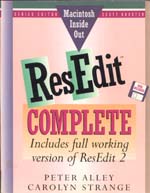


|
Title:C Programming Techniques for the Macintosh (1986) Authors: Mednieks, Zigurd R. & Schilke, Terry M. Editor: Howard W. Sams & Company ISBN: 0-672-22461-5
Usefulness: |
|
Pros: Covers the basics in macintosh C, so it could be used as an entry book for it. Contains a nice general review of all the toolbox functions. Small section about debugging. Cons: Too basic, not enough relevant for game programming. |
|

|
Title:Inside Macintosh Volumes I, II, and III (1983,1985) Authors: Various authors in Apple Computer, Inc. Editor: Addison-Wesley ISBN: 0-201-17737-4
Usefulness: |
|
Pros: (see my page about Inside Macintosh). Very convenient 3-in-1 format. Useful to have to study the different managers. This, combined with the THINK Reference mac application gives you a solid start for understand how the mac works. Cons: Some things are explained badly. Contains some errors. Sometimes you get the feeling you have to understand 5 chapters at once to get going. With time, you start to guess how to code an example from a given section, but before that happens, you'll end up looking for code examples outside of that book. |
|

|
Title:Inside Macintosh Volume IV (1986) Authors: Various authors in Apple Computer, Inc. Editor: Addison-Wesley ISBN: 0-201-05409-4
Usefulness: |
|
Pros: Adds information pertaining to the Mac 512ke and Mac Plus. Cons: Only minimally useful. Specific info for those machines doesn't influence in any way the general goal of trying to make an application that can run across all macs. All this information is superseded by what you can find in the THINK Reference application or the "universal C headers" of a compiler like THINK C. |
|

|
Title:Macintosh Game Animation (1985) Author: Person, Ron Editor: Osborne McGraw-Hill ISBN: 0-07-881127-9
Usefulness: |
|
Pros: Good basic guide on general animation. Very good discussion on the cleanup you need to do for b&w sprites moving on a b&w background. Lots of example codes that lead to small animation utilities. Good place to start if you want to do things in Basic and wait a bit before you tackle tougher languages like C or Pascal. Cons: All the code is in MS BASIC 2.0! I wrote in one of the longest ones, a sprite animation tool, and it was bugged. |
|

|
Title:Macintosh Programming Primer Volume I: Inside the Toolbox Using THINK C (1992) Authors: Mark, Dave & Reed, Cartwright Editor: Addison-Wesley Longman ISBN: 0-201-60838-3
Usefulness: |
|
Pros: Best presentation anywhere of code examples. Best introductory book that teaches you how to assemble apps together with resources, using THINK C. Teaches the event loop. Gives lots of program codes, then follows each one with a full explanation. Cons: Not much is directly related to games, but this book is absolutely a must for someone who is learning to code in C on a mac. |
|

|
Title:Macintosh Programming Primer Volume II: Mastering the Toolbox Using THINK (1990) Author: Mark, Dave Editor: Addison-Wesley ISBN: 0-201-57016-5
Usefulness: |
|
Pros: More of the same greatness started in the first volume. Walks you through dialog filter procedures. Introduces color quickdraw. Teaches you how to use TextEdit thoroughly (which is essential for anything with dynamic text that you want to do). Also contains a section on oriented programming (though not exactly C++) Cons: Only minimally directly useful for game programming. Color Quickdraw uses GWorld, which work on System 7 and up only. |
|

|
Title:Programming C on the Macintosh (1986) Author: Ward, Terry A. Editor: Scott, Foresman ISBN: 0-673-18274-6
Usefulness: |
|
Pros: Contains full source code of Megaroids II. That code is one of the rare sources on any old mac programming book for info on dealing with game animation, game sound, handling several moving objects, arcade-like speed, etc. Cons: Code intended for the very archaic Megamax compiler. Contains hard to port assembler routines on a general mac. Uses low-level memory addresses (always discouraged by Apple) which only work in the very earliest compact macs. It is possible to account for all these difficulties and to write a version that would be more compatible across all pre-OSX macs, but the work is non-negligeable. Good knowledge of the universal header syntax needed to do this conversion. All the graphics are given in hexadecimal in the source code - those are pages upon pages of mindless characters to punch in! |
|

|
Title:Programming Starter Kit for Macintosh (1995) Author: Trudeau, Jim Editor: Hayden Books ISBN: 1-56830-14-X
Usefulness: |
|
Pros: Superb, gigantic book detailed everything about C mac programming. Resources. Using Codewarrior. Introduction to C. Includes a CD full of utilities, a lite version of CodeWarrior, and the complete source code of Glypha III, a "Joust"-like game (from the arcades). If you can only get one book on this webpage, it's this one. Cons: Some small parts of the code is System 7 dependant, but it should be easy to identify (drag and drop features, multitasking apple events, etc). The glypha III source code also uses the Sound Manager of system 7. |
|

|
Title:ResEdit Complete (1991) Authors: Alley, Peter & Strange, Carolyn Editor: Addison-Wesley ISBN: 0-201-55075-X
Usefulness: |
|
Pros: Contains everything you need to know about resources. Great for someone unfamiliar with this aspect of the macintosh Cons: ResEdit is such an easy program to use, the book is not that useful. You can learn pretty quickly by checking out how other apps use resources by just opening them with ResEdit. |
|
Last Update: 10.22.05



